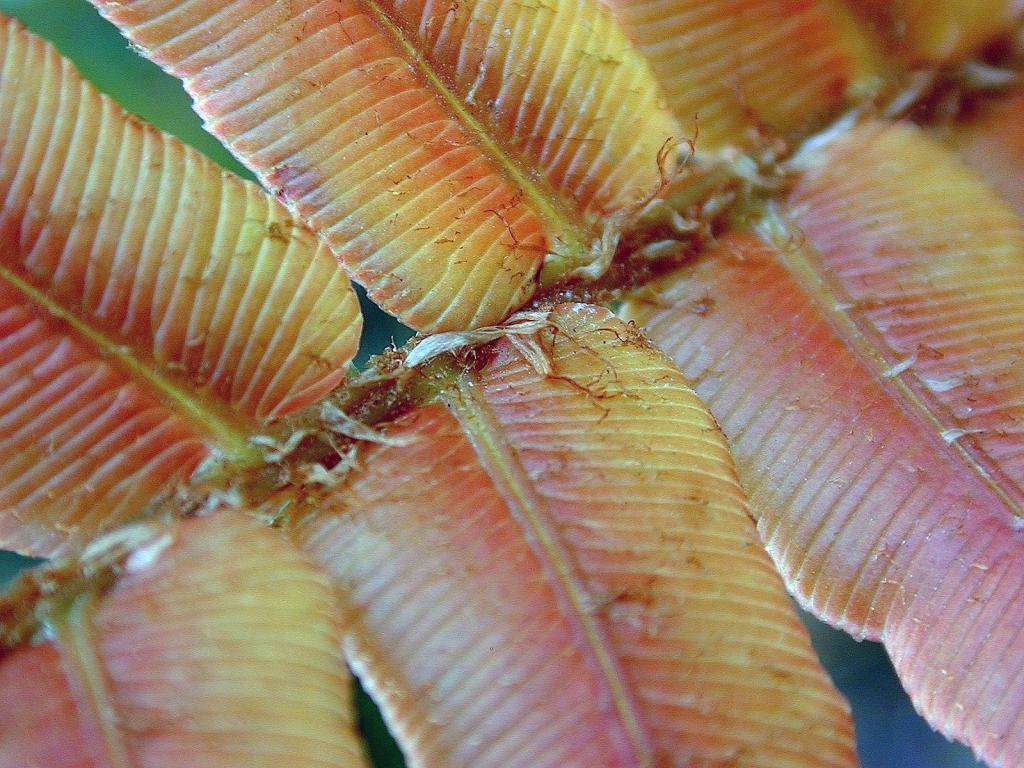Blechnum wattsii
Tindale Hard Water-fernRhizome creeping, sometimes branched, coarse, clad in dark brown scales. Fronds spread along rhizome, erect, harsh, 30–125 cm tall; sterile and fertile fronds dissimilar; young fronds tinged pink to bronze. Stipe long, fawn to straw-coloured; scales with broad bases and tapering tips, shiny, dark brown with pale margin. Sterile frond lamina broadly oblong to ovate, once pinnate, dull, dark green; rachis and underside of pinna-midribs with scattered scales which are narrower and more papery than those of stipe; pinnae shortly stalked, broadly oblong with bases lobed or truncate, lower pinnae scarcely shorter than those above, not widely separated; margins finely toothed, tips acute to rounded; terminal pinna long. Fertile fronds commonly taller than sterile; pinnae linear, long and coarse. Sori covering underside of lamina on each side of mid-vein.
GleP, VVP, VRiv, GipP, OtP, WaP, CVU, GGr, DunT, NIS, EGL, EGU, WPro, HSF, HNF, OtR, Strz, MonT, HFE, VAlp. Also ?SA, Qld, NSW, Tas. (including Bass Strait islands). Locally dominant on shaded, periodically wet alluvial flats and humus-rich forest-floors of tall open-forests, tall scrubs and rainforests, in foothills and mountains mostly on and south of the Great Dividing Range.
Fronds are usually quite harsh and with stout, relatively short pinnae. Occasionally fronds are fertile on one side of main rachis only. There are a number of relatively distinct entities in Australia and New Zealand allied to B. wattsii which seem to warrant taxonomic recognition. In Victoria, a variant from the Otway Range, lower Glenelg River area and far East Gippsland has pale brown to straw-coloured scales on stipe and rachises, and pinnae which are narrower, more widely spaced, paler, less leathery and usually more tapering at the tips than those of B. wattsii. Young fronds are not tinged pink as in B. wattsii, and occasional fronds have pinnae with irregularly fragmented (erose) margins. These plants are concordant with 'Blechnum sp. (King Island)' in Jones & Clemesha (1981, p. 104), occurring in Tasmania (including King Is. and Flinders Is.) and South Australia (Jones & Clemesha 1981; Duncan & Isaac 1986). Some plants from far-eastern Victoria also have pale brown scales, but they appear to be otherwise similar to typical B. wattsii. A thorough revision of the B. wattsii aggregate in both New Zealand and Australia is needed before any new species can be adequately circumscribed.
Entwisle, T.J. (1994). Ferns and allied plants (Psilophyta, Lycopodiophyta, Polypodiophyta). In: Walsh, N.G.; Entwisle, T.J., Flora of Victoria Vol. 2, Ferns and Allied Plants, Conifers and Monocotyledons, pp. 13–111. Inkata Press, Melbourne.
 Spinning
Spinning


